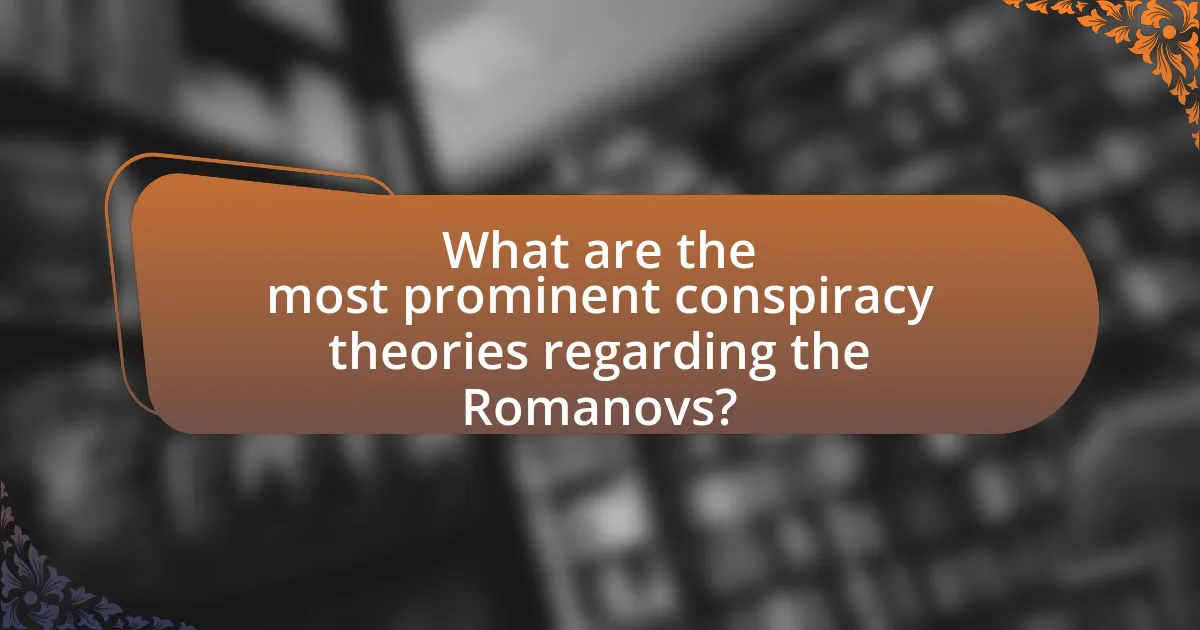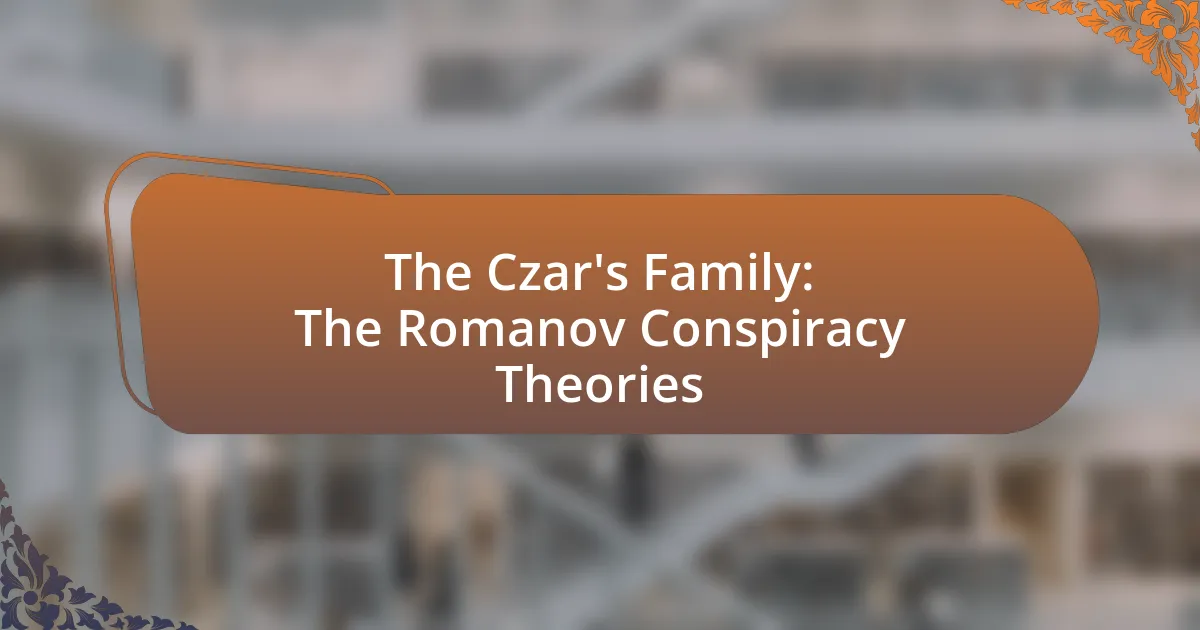The main entity of the article is the Romanov family, the last imperial dynasty of Russia, which ruled from 1613 until their execution in 1918. The article outlines key events in the Romanovs’ history, including their rise to power, significant milestones during their reign, and the factors leading to their downfall amid the Russian Revolution. It also explores the conspiracy theories surrounding the family’s fate, particularly the claims of survival of Anastasia Romanov, and examines how these theories have influenced popular culture and historical narratives. Additionally, the article discusses the implications of believing in such theories and emphasizes the importance of historical accuracy and critical thinking in understanding the Romanov legacy.

What are the key events surrounding the Romanov family?
The key events surrounding the Romanov family include their rise to power, the abdication of Tsar Nicholas II, and their execution in 1918. The Romanovs ruled Russia for over 300 years, beginning with Michael Romanov in 1613. In March 1917, amidst the Russian Revolution, Tsar Nicholas II abdicated the throne, leading to the family’s imprisonment. On July 17, 1918, the Bolsheviks executed Nicholas II, his wife Alexandra, and their five children in Ekaterinburg, marking the end of the Romanov dynasty. These events are pivotal in understanding the historical context of the Romanovs and the subsequent conspiracy theories regarding their fate.
How did the Romanov dynasty come to power?
The Romanov dynasty came to power in Russia in 1613 after a period of political instability known as the Time of Troubles. This era followed the death of Tsar Ivan IV, leading to a power vacuum and civil unrest. The Romanovs were elected by the Zemsky Sobor, a national assembly, which sought a stable ruler to unify the country. Michael Romanov, a 16-year-old relative of Ivan IV, was chosen, marking the beginning of over 300 years of Romanov rule. This selection was influenced by the family’s noble lineage and connections, as well as their perceived ability to restore order in Russia.
What were the significant milestones in the Romanov reign?
The significant milestones in the Romanov reign include the establishment of the Romanov dynasty in 1613, the expansion of the Russian Empire under Peter the Great, the westernization efforts during the reign of Catherine the Great, the emancipation of the serfs in 1861 by Alexander II, and the abdication of Nicholas II in 1917, which marked the end of the dynasty. The Romanov dynasty began when Michael Romanov was elected Tsar, leading to over 300 years of rule. Peter the Great’s reign (1682-1725) saw significant territorial expansion and modernization of the military and government. Catherine the Great (1762-1796) further expanded the empire and promoted the arts and education. Alexander II’s emancipation reform was a pivotal moment in Russian history, aiming to modernize the economy and society. Finally, Nicholas II’s abdication during the Russian Revolution led to the eventual execution of the royal family in 1918, ending the Romanov rule.
How did the political landscape of Russia influence the Romanovs?
The political landscape of Russia significantly influenced the Romanovs by shaping their governance strategies and public perception. The Romanov dynasty, ruling from 1613 until 1917, faced various political challenges, including social unrest, revolutionary movements, and the pressures of modernization. For instance, the rise of revolutionary ideologies in the late 19th and early 20th centuries, particularly Marxism, directly threatened the autocratic rule of the Romanovs, leading to events such as the 1905 Revolution, which forced Tsar Nicholas II to concede to a constitutional assembly. Additionally, the political turmoil during World War I, characterized by military failures and economic hardship, eroded public support for the monarchy, ultimately culminating in the abdication of Nicholas II in 1917. These factors illustrate how the shifting political dynamics in Russia directly impacted the stability and fate of the Romanov family.
What led to the downfall of the Romanov family?
The downfall of the Romanov family was primarily caused by widespread discontent among the Russian populace, exacerbated by military failures in World War I and economic hardship. The Russian Revolution of 1917, fueled by social unrest and political opposition, led to the abdication of Tsar Nicholas II. Following his abdication, the Bolsheviks seized power, ultimately resulting in the execution of the Romanov family in July 1918. Historical evidence shows that the combination of military defeats, economic instability, and the rise of revolutionary movements directly contributed to the collapse of the Romanov dynasty.
What were the main factors contributing to the Russian Revolution?
The main factors contributing to the Russian Revolution were widespread social discontent, economic hardship, and political repression. Social discontent arose from the vast inequalities between the aristocracy and the peasantry, with the majority of the population living in poverty while a small elite held significant wealth and power. Economic hardship was exacerbated by World War I, which strained resources and led to food shortages, inflation, and unemployment. Political repression under Tsar Nicholas II, characterized by autocratic rule and lack of political freedoms, fueled revolutionary sentiments among various groups, including workers, soldiers, and intellectuals. These factors collectively created an environment ripe for revolution, culminating in the abdication of the Tsar in 1917.
How did World War I impact the Romanov dynasty?
World War I significantly weakened the Romanov dynasty, leading to its eventual downfall. The war exacerbated existing social and economic issues in Russia, causing widespread discontent among the populace. Military defeats, such as the Battle of Tannenberg in 1914, diminished public confidence in Tsar Nicholas II’s leadership. Additionally, the strain of war led to food shortages and inflation, further fueling unrest. By 1917, these factors culminated in the February Revolution, which resulted in the abdication of Nicholas II and the end of over three centuries of Romanov rule.

What are the most prominent conspiracy theories regarding the Romanovs?
The most prominent conspiracy theories regarding the Romanovs include the survival of Anastasia Romanov, the claim that the family was not executed but instead escaped, and the idea that the Bolsheviks were not solely responsible for their deaths. The theory of Anastasia’s survival gained significant traction after numerous individuals claimed to be her, with the most famous being Anna Anderson, who emerged in the 1920s. Historical evidence, such as the discovery of the Romanov remains in 1991 and subsequent DNA testing, has largely debunked these theories, confirming that the family was executed in 1918. Additionally, some conspiracy theories suggest that foreign powers, including Britain and Germany, had a hand in the Romanovs’ downfall, reflecting the political intrigue surrounding the Russian Revolution.
What theories exist about the survival of Anastasia Romanov?
Theories about the survival of Anastasia Romanov include claims that she escaped the execution of her family in 1918 and lived under various identities. One prominent theory suggests that Anastasia was rescued by a sympathetic guard, allowing her to live in secrecy. Another theory posits that she assumed the identity of Anna Anderson, a woman who claimed to be the Grand Duchess and garnered significant public attention. Historical evidence, such as the lack of definitive remains for Anastasia among the Romanov family discovered in 1991, fuels speculation about her potential survival. Additionally, testimonies from individuals claiming to have encountered her further support these theories, although they remain unverified.
What evidence supports claims of Anastasia’s survival?
Claims of Anastasia’s survival are supported by several pieces of evidence, including eyewitness testimonies and the discovery of a woman named Anna Anderson, who claimed to be Anastasia. Anderson’s assertions gained traction due to her physical resemblance to the Romanov family and her detailed knowledge of their lives. Additionally, in 1991, the remains of the Romanov family were discovered, but the absence of Anastasia’s remains fueled speculation about her potential escape. Furthermore, various reports from the 1920s and 1930s described sightings of a woman resembling Anastasia in Europe, which contributed to the belief that she had survived the execution.
How have these claims been debunked or validated over time?
Claims regarding the Romanov family’s survival have been both debunked and validated through various historical investigations and DNA analysis. For instance, the 1991 discovery of the Romanov remains in Ekaterinburg provided concrete evidence that the family was executed, countering theories of their survival. Subsequent DNA testing confirmed the identities of the remains, aligning with historical accounts of the family’s fate. However, claims of surviving members, such as Anna Anderson, were validated for a time until DNA testing in the 1990s disproved her assertions, establishing that she was not related to the Romanovs. Thus, while some conspiracy theories gained traction, rigorous scientific methods have largely debunked them over time.
How do conspiracy theories explain the fate of the entire Romanov family?
Conspiracy theories explain the fate of the entire Romanov family by suggesting that they did not die in the Bolshevik execution in 1918, but instead escaped and lived in secrecy. These theories often claim that members of the family were smuggled out of Russia and that various individuals, including impostors, have surfaced over the years claiming to be surviving Romanovs. For instance, the most famous case is that of Anna Anderson, who asserted she was Anastasia Romanov, leading to widespread speculation about the family’s survival. Historical evidence, such as the discovery of the Romanov remains in 1991 and subsequent DNA testing, has largely debunked these theories, confirming that the family was executed. However, the allure of the conspiracy persists due to the dramatic nature of their story and the mystery surrounding their deaths.
What alternative narratives exist about the execution of the Romanovs?
Alternative narratives about the execution of the Romanovs suggest that the family may not have been killed in the manner officially reported. One prominent theory posits that some members, particularly Anastasia and Alexei, survived the execution and escaped, supported by numerous alleged sightings and testimonies over the years. Additionally, some conspiracy theories claim that the Bolsheviks staged the execution to eliminate the Romanovs as a political threat while allowing them to live in secrecy. Historical accounts, such as those from eyewitnesses and later investigations, have fueled these narratives, despite the consensus among historians that the Romanovs were executed on July 17, 1918, in Yekaterinburg.
How have historical interpretations of the Romanov execution evolved?
Historical interpretations of the Romanov execution have evolved significantly from initial accounts to contemporary analyses. Initially, the execution was viewed primarily as a brutal act of Bolshevik vengeance against the imperial family, emphasizing the political motivations behind their deaths. Over time, interpretations have shifted to include a broader context, examining the social and psychological factors that influenced the Bolsheviks’ decision, as well as the implications of the Romanovs’ legacy in Russian history. Recent scholarship has also focused on the role of myth-making and conspiracy theories surrounding the execution, highlighting how these narratives have shaped public perception and historical discourse. For instance, the discovery of the Romanov remains in 1991 and subsequent DNA testing have prompted reevaluations of the events, leading to debates about the authenticity of various accounts and the motivations of those involved.

What impact have these conspiracy theories had on popular culture?
Conspiracy theories surrounding the Romanov family have significantly influenced popular culture by inspiring numerous films, books, and television series. For instance, the animated film “Anastasia” (1997) portrays a fictionalized account of the youngest Romanov daughter, blending historical elements with fantasy, which has led to a resurgence of interest in the Romanovs. Additionally, the theories have permeated literature, with novels like “The Romanov Prophecy” by Steve Berry exploring the mysteries and speculations surrounding the family’s fate. This cultural fascination reflects a broader trend where conspiracy theories serve as a narrative device, allowing creators to engage audiences with themes of intrigue, loss, and identity.
How have films and literature portrayed the Romanov conspiracy theories?
Films and literature have portrayed the Romanov conspiracy theories as a blend of historical intrigue and speculative fiction, often suggesting that members of the Romanov family survived the 1918 execution. Notable examples include the animated film “Anastasia,” which presents a fictional narrative where the youngest daughter escapes and lives incognito, reflecting a romanticized view of the conspiracy. Similarly, the novel “The Lost Crown” by Sarah Miller explores the lives of the Romanov daughters, intertwining historical facts with the possibility of their survival. These portrayals often emphasize themes of identity, loss, and the quest for truth, while also drawing on the enduring fascination with the mystery surrounding the Romanovs.
What are some notable films that depict the Romanov family and their fate?
Notable films that depict the Romanov family and their fate include “Anastasia” (1997), an animated musical that presents a fictionalized account of the youngest Romanov daughter’s survival, and “The Romanoffs” (2018), a television anthology series that explores various stories connected to the Romanov legacy. Additionally, “Nicholas and Alexandra” (1971) dramatizes the last years of Tsar Nicholas II and his family, focusing on their tragic end during the Russian Revolution. These films illustrate the historical context and the dramatic events surrounding the Romanov family’s demise.
How has literature contributed to the mythos surrounding the Romanovs?
Literature has significantly contributed to the mythos surrounding the Romanovs by shaping public perception and creating narratives that blend fact with fiction. Historical novels, biographies, and plays have romanticized the lives of the Romanov family, often portraying them as tragic figures or martyrs, which enhances their mystique. For example, works like “Anastasia: The Riddle of Anna Anderson” by James Blair Lovelace and “The Romanovs: 1613-1918” by Simon Sebag Montefiore provide detailed accounts that intertwine historical events with dramatic storytelling, influencing how audiences view the family’s legacy. Additionally, fictional portrayals in films and literature, such as the animated movie “Anastasia,” have perpetuated myths about the family’s survival and the possibility of lost heirs, further embedding these narratives into popular culture. These literary contributions have not only preserved the Romanovs’ story but have also transformed it into a complex tapestry of intrigue, tragedy, and enduring fascination.
What role do conspiracy theories play in shaping historical narratives?
Conspiracy theories significantly influence historical narratives by providing alternative interpretations of events that challenge official accounts. In the context of the Romanov family, theories surrounding their fate after the 1917 revolution have shaped public perception and historical discourse. For instance, claims that some Romanovs survived the execution have led to ongoing debates about identity and legitimacy, impacting how history is taught and understood. The persistence of these theories reflects societal needs for mystery and the search for truth, as evidenced by the numerous investigations and cultural representations that continue to explore these narratives.
How do conspiracy theories affect public perception of historical events?
Conspiracy theories significantly distort public perception of historical events by introducing alternative narratives that often contradict established facts. In the case of the Romanov family, theories suggesting that members survived the 1918 execution have led to widespread skepticism about the historical account of their deaths. This skepticism is fueled by the allure of mystery and the emotional investment in the idea of survival, which can overshadow factual evidence, such as the findings of forensic investigations that confirmed the identities of the remains found in Ekaterinburg. Consequently, these theories can create a fragmented understanding of history, where sensationalized accounts gain traction over verified historical records, ultimately shaping collective memory in a way that prioritizes intrigue over accuracy.
What are the implications of believing in conspiracy theories about the Romanovs?
Believing in conspiracy theories about the Romanovs can lead to a distorted understanding of historical events and the legacy of the Russian monarchy. These theories often promote misinformation, which can undermine factual historical narratives and contribute to a culture of skepticism towards credible sources. For instance, the belief that Anastasia survived the execution of her family has persisted despite DNA evidence confirming the deaths of the Romanovs in 1918. This misinformation can perpetuate myths that distract from the real historical context of the Russian Revolution and its impact on modern Russia. Additionally, such beliefs can foster divisive ideologies, as they often appeal to nationalist sentiments or romanticized views of the monarchy, complicating contemporary discussions about history and identity in Russia.
What can we learn from the Romanov conspiracy theories today?
The Romanov conspiracy theories today illustrate the enduring impact of historical narratives on public perception and identity. These theories reveal how collective memory can shape cultural and national identities, as seen in Russia’s ongoing fascination with the Romanovs, which reflects a longing for a lost imperial past. Additionally, the theories highlight the role of misinformation and sensationalism in shaping historical discourse, as various claims about the survival of Anastasia and other family members have persisted despite lack of evidence. This underscores the importance of critical thinking and historical literacy in evaluating claims about the past.
How can critical thinking be applied to historical conspiracy theories?
Critical thinking can be applied to historical conspiracy theories by systematically analyzing the evidence, questioning assumptions, and evaluating the credibility of sources. For instance, in the case of the Romanov family, critical thinking involves examining the various claims about their survival after the 1918 execution, such as the assertions made by individuals claiming to be Anastasia. By scrutinizing historical documents, eyewitness accounts, and forensic evidence, one can assess the validity of these claims. The 2007 DNA analysis of remains found in Ekaterinburg, which confirmed the identities of the Romanovs, serves as a concrete example of how critical thinking can debunk unfounded conspiracy theories.
What lessons can be drawn about the importance of historical accuracy?
Historical accuracy is crucial as it shapes our understanding of events, influences public perception, and informs future decisions. In the context of the Romanov family, the accuracy of historical accounts directly impacts the interpretation of their legacy and the events surrounding their demise. For instance, the varying narratives about the Romanovs’ execution have led to conspiracy theories that distort public perception and create misinformation. Accurate historical records, such as eyewitness accounts and forensic evidence, are essential in debunking myths and clarifying the truth about their fate. This underscores the necessity of rigorous historical research to prevent the spread of false narratives and ensure a well-informed society.
